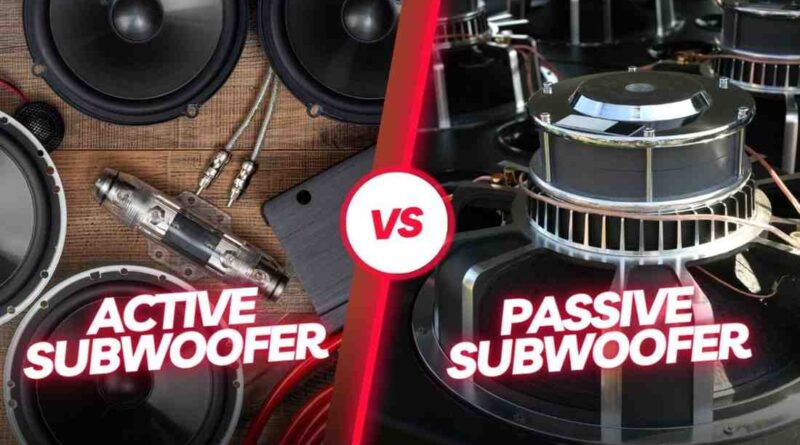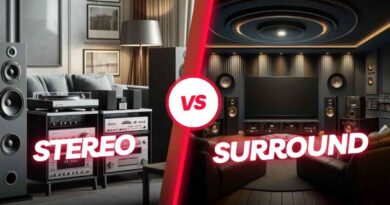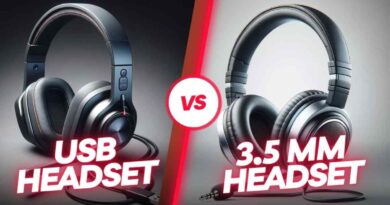Active vs. Passive Subwoofer: What’s The Main Difference?
Are you confused about whether to choose an active or passive subwoofer for your sound system? Understanding the difference between these two types of subwoofers is crucial for anyone looking to enhance their audio experience.
- Active subwoofers, also known as powered subwoofers, come with a built-in amplifier that powers the speaker, eliminating the need for an external amplifier. This integration not only simplifies setup but also optimizes sound quality by matching the amplifier with the subwoofer.
- On the other hand, passive subwoofers require an external amplifier or receiver to function. They offer flexibility in customizing audio systems, as you can choose an amplifier that meets your specific power and performance needs.
This blog post will explore the key distinctions, advantages, and considerations for both active and passive subwoofers, helping you make an informed decision on the best fit for your audio setup.
Active vs. Passive Subwoofer
What is an Active Subwoofer?
An active subwoofer, often termed a powered subwoofer, incorporates a built-in amplifier. This design simplifies its integration into any audio setup by eliminating the need for an external amplifier. The primary advantage of this configuration is the manufacturer’s ability to match the subwoofer with an optimal amplifier, enhancing overall sound quality and efficiency.
Key Characteristics:
- Built-in Amplifier: The amplifier is specifically tailored to the subwoofer’s specifications, ensuring optimal performance.
- Ease of Installation: With fewer components to connect, setting up an active subwoofer is straightforward and user-friendly.
- Space Efficiency: Since it houses all necessary components internally, it saves space, making it ideal for smaller rooms or setups where minimalism is key.
Advantages:
- Optimized Performance: The integrated amplifier is designed to complement the subwoofer’s capabilities, leading to better sound precision and quality.
- Convenience: Reduces the clutter and complexity of additional wiring and equipment.
- Control Features: Many active subwoofers come with adjustable settings like volume, phase, and crossover frequency, which can be tailored to suit the listener’s preference.
Ideal Usage Scenarios:
- Home Theaters: Perfect for users who desire a plug-and-play solution for enhancing their home cinema experience.
- Gaming Setups: Gamers can benefit from the deep and immersive sounds without complex setups.
- Compact Spaces: Excellent for environments where space is at a premium but quality audio is desired.
This type of subwoofer is particularly appealing to those new to audio systems or those looking for a straightforward solution without the intricacies of matching components.
What is a Passive Subwoofer?
A passive subwoofer, in contrast to its active counterpart, does not include a built-in amplifier. This type requires an external amplifier or receiver to power it, offering a higher degree of customization in audio systems. This flexibility is beneficial for audio enthusiasts who prefer to tailor their sound systems to specific preferences or for setups that require integration with complex multi-channel systems.
Key Characteristics:
- External Amplification Required: The subwoofer needs to be connected to an external amplifier, which can be chosen based on desired power output and quality.
- Versatility in Setup: Allows for extensive customization in terms of amplifier choice and audio configuration.
- Higher Potential Power Handling: Depending on the external amplifier used, passive subwoofers can handle more power, which is ideal for large spaces.
Advantages:
Customization: Users can select amplifiers that match their specific power needs and acoustic preferences, allowing for a more tailored audio experience.
Upgradability: It’s easier to upgrade components individually without replacing the entire system.
Cost-Effectiveness: In some cases, using a passive subwoofer can be less expensive, especially if you already own a compatible amplifier.
Ideal Usage Scenarios:
Advanced Home Theater Systems: For audiophiles looking to achieve the best possible sound by carefully selecting and matching components.
Large Venues or Outdoor Settings: Effective in environments where very high output is necessary, and the ability to choose powerful amplifiers can be a significant advantage.
Custom Audio Projects: Ideal for DIY enthusiasts who enjoy assembling and fine-tuning their systems for optimized performance.
Passive subwoofers appeal to those with a bit more experience in audio systems or to those who seek to exert greater control over every aspect of their audio setup.
Comparing Active and Passive Subwoofers
When choosing between an active and a passive subwoofer, several key differences influence their performance, setup complexity, and suitability for different environments and preferences. Here’s a detailed comparison:
Sound Quality Differences:
- Active Subwoofers: These typically provide a more consistent and optimized sound because the built-in amplifier is specifically designed to match the subwoofer’s characteristics. This ensures a balanced output that is hard to achieve with separate components.
- Passive Subwoofers: The sound quality depends significantly on the choice of external amplifier. While this allows for customized sound tuning, it also requires a deeper understanding of audio components to achieve the best results.
Power Handling and Efficiency:
- Active Subwoofers: They are generally more efficient with their power usage since the amplifier and subwoofer are designed to work together optimally. This integration tends to produce better performance even at lower power settings.
- Passive Subwoofers: They can handle more power depending on the external amplifier’s capabilities. This makes them suitable for larger spaces where high volume and power are needed.
Setup Complexity:
- Active Subwoofers: Easier to set up due to fewer components needing connection. This plug-and-play nature makes them appealing to those who prefer simplicity and convenience.
- Passive Subwoofers: Require more knowledge to correctly match the subwoofer with an appropriate amplifier. The setup is more complex but offers more flexibility and customization.
Understanding these differences can help you decide which type of subwoofer aligns best with your audio needs, considering factors like ease of setup, sound quality expectations, and the specific characteristics of your listening environment.
Considerations When Choosing Between Active and Passive Subwoofers
Selecting the right type of subwoofer involves more than just comparing specifications; it requires considering the specific needs of your audio setup and personal preferences. Here are key considerations to help guide your decision:
Room Size and Acoustics:
- Active Subwoofers: Best suited for smaller to medium-sized rooms where space and simplicity are prioritized. Their built-in amplifiers are optimized for the unit, providing adequate power and quality sound without overwhelming the space.
- Passive Subwoofers: Ideal for larger rooms or outdoor settings where a powerful, customizable sound is necessary. The ability to choose a separate, potentially more powerful amplifier makes them more adaptable to challenging acoustic environments.
Compatibility with Other Audio Components:
- Active Subwoofers: Since they come with an integrated amplifier, there’s less worry about compatibility issues. They are a good choice for straightforward systems or when adding to an existing setup where you don’t want to adjust other components.
- Passive Subwoofers: They require careful selection to ensure the external amplifier not only matches the subwoofer’s power needs but also works harmoniously with other components in your system. This is crucial for maintaining sound quality and system stability.
Budget Considerations:
- Active Subwoofers: Generally, they might be more expensive initially due to the built-in amplifier, but they offer a hassle-free setup and operation.
- Passive Subwoofers: Typically less expensive by themselves, but the total cost can increase once you factor in the price of an external amplifier. However, they provide the flexibility to upgrade components individually over time.
By weighing these considerations against your personal needs and the specifics of your audio environment, you can make a more informed choice between an active and passive subwoofer, ensuring the best possible audio experience.
Conclusion
Choosing between an active and a passive subwoofer depends largely on your specific audio needs, expertise in setting up sound systems, and the environment in which the subwoofer will be used. Active subwoofers offer a straightforward, all-in-one solution that is ideal for those who value convenience and space-saving designs. They are particularly beneficial in smaller rooms or for users who prefer not to delve into the complexities of audio component matching.
On the other hand, passive subwoofers cater to those who enjoy customizing their audio systems. They are suitable for larger spaces or for audiophiles willing to invest time and effort into selecting the perfect amplifier to complement their subwoofer. This type allows for greater flexibility and potential upgrades, which can be appealing to those who view their sound systems as long-term investments.
In summary, active subwoofers are best for users looking for simplicity and ease of use, while passive subwoofers are ideal for those seeking optimal performance tailored to specific listening environments and preferences. Consider your room’s acoustics, your budget, and your willingness to engage with audio technology when making your choice. Whichever type you choose, the right subwoofer can greatly enhance your listening experience, bringing powerful, detailed bass to your audio system.
Frequently Asked Questions
What is the main difference between an active and a passive subwoofer?
The main difference is that an active subwoofer has a built-in amplifier, making it ready to use out of the box, whereas a passive subwoofer requires an external amplifier to function, offering more customization in audio setups.
Can I use any amplifier with a passive subwoofer?
Not all amplifiers will be compatible with every passive subwoofer. It’s crucial to match the power output and impedance of the amplifier to the specifications of the passive subwoofer to ensure optimal performance and prevent damage.
Are active subwoofers better than passive subwoofers?
Neither type is inherently better; the choice depends on specific needs. Active subwoofers are ideal for simplicity and ease of setup, while passive subwoofers offer more flexibility for customizing sound quality.
Do active subwoofers consume more power than passive subwoofers?
Active subwoofers do not necessarily consume more power. Their built-in amplifiers are designed to efficiently power the subwoofer, potentially making them more energy-efficient depending on the model.
How do I choose the right size subwoofer for my room?
The size of the subwoofer should match the size of the room. Larger rooms typically require larger subwoofers to fill the space with sound adequately, while smaller rooms can benefit from compact subwoofers.
Can I integrate a passive subwoofer with my existing home theater system?
Yes, a passive subwoofer can be integrated into an existing system, but it requires careful matching with a suitable amplifier that complements the other components in terms of power and sound characteristics.
What are the installation challenges for passive subwoofers?
Installation challenges for passive subwoofers include the need for additional cabling, correct placement for optimal sound, and ensuring that the amplifier and subwoofer are properly matched and configured.
Are there any reliability differences between active and passive subwoofers?
Reliability can vary widely between models rather than types. However, active subwoofers have fewer components that the user needs to manage, which might lead to fewer issues over time due to less handling.
Can passive subwoofers be used for professional audio systems?
Yes, passive subwoofers are often used in professional audio systems where customization and the ability to handle higher power are required. They are common in concert settings, theaters, and other professional venues.
How do I know if my subwoofer setup is optimized?
An optimized subwoofer setup will produce clear, distortion-free bass, evenly distributed across the listening area. It’s often worthwhile to consult with an audio professional or refer to specific calibration guides to ensure optimal setup.




